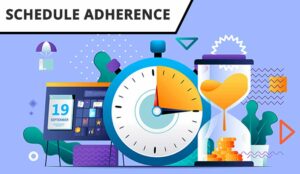The Not Ready Rate is an important metric for measuring how much time contact centre agents spend on non-productive activities relative to their total available working time.
We asked Steve Rongevær-Boother, Sales Engineer at Calabrio, to explain how contact centres can calculate not ready rate and the formula required.
Video: How to Calculate ‘Not Ready’ Rate
Watch the video below to hear Steve explains how to calculate not ready rate:
With thanks to Steve Rongevær-Boother, Sales Engineer, Calabrio, for contributing to this video.
The Not Ready Rate Calculation
The Not Ready Rate is calculated by dividing the time an agent spends in a “not ready” status by their total logged-in time, as Steve explains:
“Put simply, the Not Ready Rate is a measurement of the time that the contact centre agent spends on tasks or activities which do not relate to their readiness to take interactions from one or more channels that they’re skilled to take interactions for.
The agent’s time spent in non-ready status is divided by the total amount of available time that they have during that shift. The result gives the not ready time percentage.”
This percentage highlights the proportion of time an agent is unavailable to handle interactions across their assigned channels.
Put simply the formula to calculate Not Ready Rate is:
Not Ready Rate = (Time in ‘Not Ready’ Status ÷ Total Available Time During Shift) × 100
For example, if an agent is logged in for 8 hours but is only “ready” for 7 hours, their Not Ready Rate would be 12.5%.
Not Ready Rate = (1 ÷ 8) × 100 = 12.5%
What Counts as Ready Time?
It is possible for multiple statuses to count towards a ready rate. For example, an agent working on inbound and outbound inquiries will be deemed ready if they’re working on either of these statuses.
Post-call or after-call work, such as writing up case notes, can also count towards ready time, provided it is properly managed.
“It is possible for multiple statuses to count towards a ready rate. For example, an agent working on inbound and outbound inquiries will be deemed ready if they’re working on either of these statuses.
Post-call or after-call work can also count towards this figure, though managers should check this at regular intervals, to ensure that after-call statuses are not being mismanaged or abused by agents.
Taking that as an example, if an agent is logged on for 8 hours, ready for 5 of those, and working outbound inquiries for 1 hour, as well as spending 1 hour in after-call work activities, for example to write up case notes, they would be ready overall for seven of the eight hours they’re logged on for, so a not ready rate of 12.5%.”
For instance:
- An agent logs in for 8 hours.
- They are ready for 5 hours, spend 1 hour on outbound inquiries, and 1 hour on after-call work.
- This results in a total of 7 hours of readiness, leaving a Not Ready Rate of 12.5%.
Managers should regularly review after-call work to ensure it is not being misused.
Not Ready Rate vs. Adherence Rate
It’s important to differentiate the Not Ready Rate from agent adherence, as Steve continues:
“One thing to bear in mind is that the not ready rate is not the same as agent adherence. Agent adherence is a measure of the matching of activities, or statuses, which the agent has in their scheduled activities from their WFM system, to the activities from the contact centre phone system, and ensuring a match between the two to maintain their adherence level.
Where the agent matches the status to the published schedule, their adherence score will increase. Where the agent does not match, their adherence score will decrease.
Again, in this situation, where an agent knows that their adherence is incorrect, they should approach their manager and make an adjustment, especially if their activities have changed.”
Adherence measures how well an agent’s activities align with their scheduled tasks as set by the workforce management (WFM) system.
- Adherence Score: Increases when the agent follows their schedule.
- Not Ready Rate: Reflects time spent unavailable, regardless of schedule adherence.
If agents notice discrepancies in adherence, they should communicate with their manager to make necessary adjustments.
Using Metrics Effectively
Agents and managers can use WFM reports to monitor both the Not Ready Rate and adherence scores.
“Agents will where possible use their WFM reports to measure their not ready rate, as well as their adherence scores. It’s therefore important to understand the difference between not ready rate and the adherence rate.”
Understanding these differences helps improve scheduling, productivity, and operational efficiency in the contact centre.
If you are looking for more great insights from the experts, check out these next:
- How to Choose Which Calls to Evaluate
- Agent Statements for Supporting Bereaved Customers
- Tips to Improve Forecast Accuracy
- Simple Ways to Speed Up After-Call Work
Author: Robyn Coppell
Reviewed by: Hannah Swankie
Published On: 19th Mar 2024 - Last modified: 25th Sep 2025
Read more about - Video, Calabrio, How to Calculate, Metrics, Steve Rongevær-Boother, Top Story, Videos





































